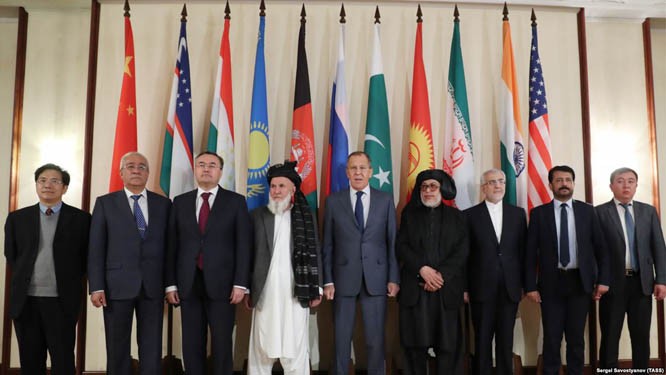
Moscow’s invitation to Taliban and the latter’s participation in the talks are emblematic of the growing relationship between Russia and Taliban

Peace talks with Taliban is as recent a phenomenon as January 2012. Since then every year efforts were made to revive talks on the making of peace in Afghanistan. These endeavours are yet to be fruitful. The latest of these efforts involves the hosting of talks between representatives from the Afghan government and Taliban rebels in Moscow, Russia. Representatives from China, Iran, Pakistan, Tajikistan, Uzbekistan and Turkmenistan were also in attendance.
Moscow’s invitation to Taliban and the latter’s participation in the talks are emblematic of the growing relationship between Russia and Taliban. In the second half of 1990s, Taliban officials, in a meeting with their Russian interlocutors in Ashgabad Turkestan, sought Russian backing of permanent seat for their regime at the UN to no avail.
Back in the mid-2010s, it was Russia that sought to establish contact with Taliban. This was followed by American accusations about Russia arming the Taliban. On the other hand, the participation of Afghan "national but non-government institution" of High Peace Council in the conference but the absence of representatives from Afghan government perhaps demonstrates the Afghan government’s lukewarm attitude to Moscow-led peace efforts. The Afghan move appears to appease the US, Russia’s regional rival. Russia and Taliban have their own reasons to embrace each other.
The conference marks the arrival of Moscow on the scene as a peace broker. Seeking a greater role in regional politics, Russia rivals American diplomacy in the southwest Asian context. Moscow sees Central Asia and Afghanistan as an area of its influence or at least considers the region as something that should be beyond the sphere of American influence. An assertive Russia has been trying to regain the ground ceded to the US back in 2002.
Apparently, Moscow, like other regional capitals, is distrustful of the US presence in Afghanistan. Countering Islamist extremism and terrorism of Taliban and others of their ilk is seen more as a means to prolonging US presence in Afghanistan. On their part, Taliban would want to sell to the world the message of their crucial role in a region hostile to US presence.
The Indian participation in the huddle and sharing table with Taliban at "nonofficial" level signals a change in New Delhi’s policy towards Taliban insurgents. The meeting is a diplomatic victory for the otherwise ostracised militant movement.
With every passing day, the Afghan theatre of war is going to fester until we take into account the interests of important stakeholders and a piecemeal approach to tackle factors due to which Afghanistan remains destabilised.
The US presence in Afghanistan fits into its overarching objective of checkmating the rise of China as a predominant state in Asia. The presence of its more than 700 airbases across the globe demonstrates the psyche of American policymakers who see their worldwide presence as indispensable for the projection of American power throughout the world.
US, India and the Afghan government and Afghan citizens, except Taliban sympathisers, would want continuity of the US presence in the country. India, with the help of US, wants to compete with its regional contender, China. The Afghan government cannot survive in office without American support. Afghan citizens, especially non-Pashtun Afghans, hugely suffered under Taliban’s reign of terror. They cannot afford retrogression to late 1990s. Several regional actors entertain a different scenario.
Ideally, China, Iran, Pakistan and Russia and Taliban would want complete pullout of the US forces from Afghanistan. Beijing, Tehran, Islamabad and Moscow see the American presence in Afghanistan as frightening if not necessarily threatening. China’s interest is in a stable Afghanistan no matter who rules the country, though a non-Islamist regime would be for sure a preferred choice.
Pakistan envisions a pro-Pakistan and anti-India regime at Kabul. Taliban envision a return to the militia’s rule of Afghanistan. Taliban exult over the US failure to stabilise Afghanistan. The humiliating withdrawal of Soviets from Afghanistan emboldened the militia to predict that the US would also face the Soviets’ fate.
Except Pakistan, Iran and Russia’s support to Taliban is transitory. The two seek to bleed the US in this war of attrition. They won’t want to see the Wahabism-influenced extremist Deobandi Taliban again as the exclusive rulers of Afghanistan. Thus, competing interests of regional states in the country are additional factors of instability there.
Even left to its own devices, Afghanistan will remain embroiled in internecine feuds. The country is a deeply divided society along tribal, ethnic, national and sectarian lines. The road towards stability in Afghanistan would, in the first place, entail US entering into an arrangement for long term stay in Afghanistan in return that Washington will cater to all external security needs of Afghanistan including protecting and defending it from outside intervention. Once they are cut off of their support from outside, Taliban will be forced to sue for peace.
In the second stage, US should enter into negotiation with Taliban and allow it to function as a political party in compliance with the constitution of Afghanistan. Pakistan can be a valuable partner for peace if its obsessive security concerns vis a vis India are somehow taken care of at the court of Kabul. The US is still the most powerful state militarily. Its security assurance carries credibility.